Artificial Disc Replacement - Life Span
Prices in Germany are normally 75% below the cost for a artificial disc replacement surgery in the US and are individually quoted. All surgeries are performed by our preferred doctor, who is the chief neurosurgeon with over 25 years experience. They include all medical expenses, the hospital stay, surgeon's fees, operation room fees, anesthesia, anesthesiologist's fees, medicine, nursing, semi-private room, meals, pre-op diagnosis, local phone and English TV.
How long will an artificial disc last in any individual patient cannot not be precisely determined by anyone, however statistics on previous patients and the knowledge of manufacturing testing can give us a fairly good estimate for the patient population in general. Because the artificial disc procedure for the lumbar spine has only been performed since the early 1990's with the artificial disc for the cervical spine soon following and because several modifications and variations to the original artificial disc design have been made, duration statistics of 20 to 40 years are not available. However, examination of the few artificial disc patients, who have died (all from reasons unrelated to the artificial disc, have shown the discs to be completely in tact. Additionally, at the time of this writing no known artificial disc failures have occurred in a living patient. Manufacturers of the artificial disc simulate the wear and tear of 40 to 50 years of life, by implanting the discs in cadavers and mechanically stressing the cadaver's back. The simulation plays a role in FDA approval. Now we even have some manufacturers guaranteeing their artificial disc replacements for 40 years.
Many try to estimate the life expectancy of an artificial disc replacement by comparing it to that of an artificial hip joint. They say that because the materials are similar in the two prostheses, that comparison is justified. But one should note that both the static and dynamic forces in these two joints are very different from the intervertebral joint, and the load in the intevertebral discs are much lighter than in the hip joints. However it is important to note that the biggest advances in hip endoprostheses are the ceramic-to-ceramic and the metal-to-highly-crosslinked polyethelene. Indeed, new hip replacement endoprostheses may now last up to 30 years, but failure is usually in the bone to prosthesis connection, not within the mechanical joint itself.
Although the goal of the manufacturers, doctors and client is for the client to have only one artificial disc replacement surgery in a life time, it is possible that young clients may indeed have more than one, due to the progression of disease.
Multi-Level Artificial Disc Replacement
Multi Level Artificial Disc Replacement
Multi Level Artificial Disc Replacement at the time of this writing is still not approved by the FDA, although the surgery has seen broad success in Germany. Even it if were approved by the FDA, there is no reason to assume insurance companies in the US would pay reimburse their clients for the expense, as many of them refuse to pay for the single leverl artificial disc replacement, having the artificial disc replacement previously declared experimental after FDA approval.
EMT considers the FDA's actions as wise, because it takes decases to train surgeons in the demanding surgery. Unfortunately for American and Canadian patients it is not available in North America. This clearly superior technology in the hands of an experienced and principled surgeon brings superior long-term relief to people suffering from degenerative disc disease, when compared to fusion.
Arrangements can be made for those who need the Multi Level Artificial Disc Replacement surgery with some of the finest and most experienced surgeons and surgical teams, by simply contacting EMT on the contact page.
Please see Artificial Disc Replacement for technical details about this disc surgery.
Artificial Disc Replacement
Artificial Disc Replacement
Artificial disc replacement prices in Germany are normally 75% below the cost for the surgery in the US and are individually quoted. These cost savings are especially realized in multi level artificial disc replacement. All surgeries are performed by the best doctors, chosen for your specific need. Costs / prices include all medical expenses, the hospital stay, surgeon's fees, operation room fees, anesthesia, anesthesiologist's fees, medicine, nursing, private room, meals, pre-op diagnosis, local phone and English TV. For artificial disc replacement surgery we are exclusively recommending Dr. Rudolf Bertagnoli.
EMT is a client advocate and charges no fees to our clients.
More technical articles about artificial disc replacement on Dr. Bertagnoli's website.
Artificial Disc Replacement: Definition
An artificial disc replacement surgery replaces the entire function of the diseased or damaged intervertabral disc of the spinal column with a man-made device. The great majority of spine surgeons consider the artificial disc replacement surgery superior to fusion in patients with healthy enough vertebral body end plates, because the mobility of the spine is preserved with the ADR. The rigid fusion is believed to transfer the stress of adjacent motion to adjacent discs and vertebrae, resulting in what is called adjacent segment syndrome. (About 22% of fusion patients report adjacent segment syndrome within five years of their surgery.) Reports of adjacent segment syndrome in artificial disc replacement surgeries are less than 1 percent.
Studies show that the artificial disc replacement surgery success rates are significantly higher than that of fusion.
Another advantage of the artificial disc replacement surgery over fusion is that no bone graph is taken from the hip, which can result in a very painful healing process.
Artificial Disc Replacement: Selection
Without a doubt advances have been made in artificial disc replacements design over the years, but not all new ideas have been successful. If a client has a particularly strong opinion about a brand, EMT will make every effort possible to follow that client's wish. However, EMT may recommend a provider that EMT trusts as the best doctor, clinic, and technology.
EMT makes no clinical judgment about the superiority of one artificial disc replacement over the other. However, EMT refers readers to the highly qualified peer-reviewed articles by the FDA Article 1 and the FDA Article 2 and by the Spine magazine Spine Magazine Article on ADR.
Artificial Disc Replacement: Selection Strategy
We think that strategy should play the dominant role in the disc selection of artificial disc replacement for people wanting to chose. First, consider the how a revision might be done. Although failure of an artificial disc replacement is extremely rare, (none to our knowledge have been reported in the devices our doctors use) how would one deal with a failure if it happened? Fusion? Plate removal? Replacement of core? The artificial disc is a device that you will have in your body for the rest of your life, therefore ample consideration for this scenario is very important. Removal of the artificial disc replacement is a very dangerous operation. Second, consider the difficulty of inserting the artificial disc replacement. Although the surgeons are highly skilled, the more complicated the surgery, the more possibilities of an error. Also, some artificial disc replacements require the doctor to excessively spread the intervertebral joint. Third, the skill level of the surgeon. A surgeon should have a least forty artificial disc replacements before you should consider using him or her. However, it is difficult for the novice medical tourist to know who is a good doctor and who is not. Interviews with nurses and former patients are often the best source of information about a doctor. This is just two of the vetting processes for doctors at EMT. However, most of doctors we use, we have had long standing relationships. Experience really counts, when dealing with doctor selection. Fourth, what is the infection rate of the surgeon for this artificial disc replacement procedure. Fifth, be part of a crowd, that is to say, don't use the newest disc on the market or discs that very few people have inserted. Much like rare cars or any other manufactured product, parts and mechanics (doctors) are hard to find for one off products. Sixth, FDA approval for the device is a plus for US and Canadian patients, as doctors are much more willing to work on an FDA approved device, than a device, which is not FDA approved.
Artificial Disc Replacement: Lumbar
Ninety percent of all artificial disc replacement surgery surgery is done on the lumbar spine with the L4/5 disc being the most often replaced disc, closely followed by the L5/S1. Most disc replacement surgery is single level but about ten percent or more involve more than one level.
Current lumbar discs available in Europe are the
-
 Activ-L Click name for large picture
Activ-L Click name for large picture -
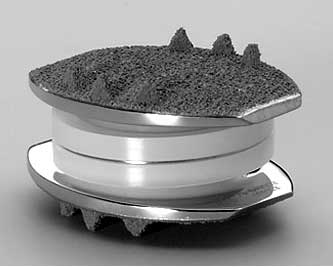 Charite Click name for large picture
Charite Click name for large picture -
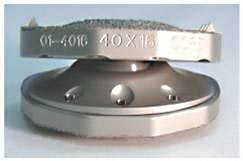 Flexicore Click name for large picture
Flexicore Click name for large picture -
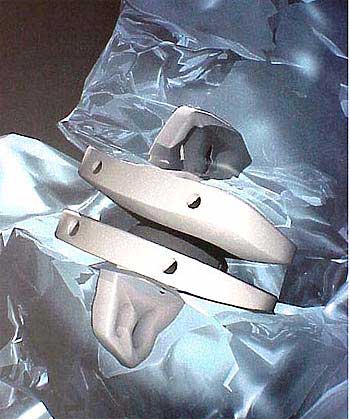 Maverick Click name for large picture
Maverick Click name for large picture -
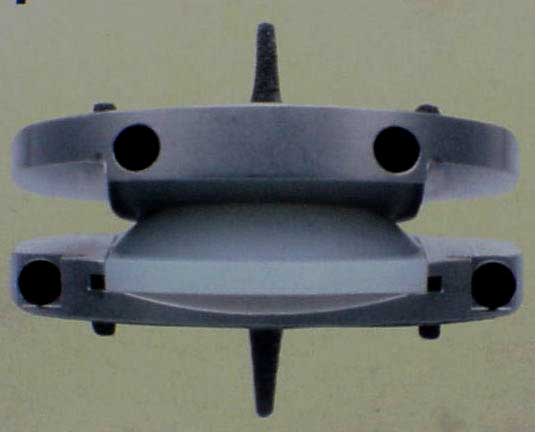 Prodisc-L Click name for large picture
Prodisc-L Click name for large picture
At the time of this writing, only the Charite and ProDisc are currently FDA approved for use in the USA. This is a consideration when choosing the type of disc for your surgery as follow-up may be easier to find in the US or Canada with an FDA approved device.
Artificial Disc Replacement: Cervical
Ten percent of all artificial disc replacement surgery is done on the cervical spine. About ten percent of these surgeries are multi-level.
Current cervical discs available in Europe are the:
-
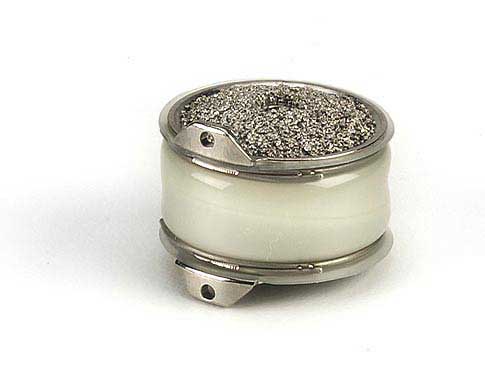 Bryan Click name for large picture
Bryan Click name for large picture -
 Cervicore Click name for large picture
Cervicore Click name for large picture -
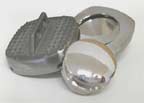 Kineflex-C Click name for large picture
Kineflex-C Click name for large picture -
 Prestige Click name for large picture
Prestige Click name for large picture -
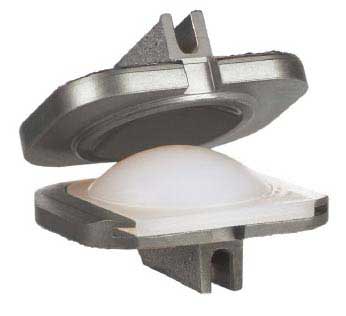 Prodisc-C Click name for large picture
Prodisc-C Click name for large picture -
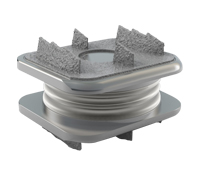 Spinal Kinetics M6 Click name for large picture
Spinal Kinetics M6 Click name for large picture -
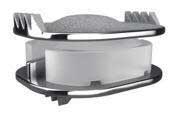 Mobi-C Click name for large picture
Mobi-C Click name for large picture -
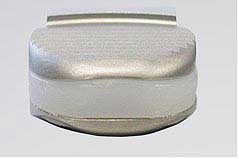 PCM (Porous Coated Motion) Click name for large picture
PCM (Porous Coated Motion) Click name for large picture -
 Medtronic Sofamor Danek Prestige Click name for large picture
Medtronic Sofamor Danek Prestige Click name for large picture -
 Secure-C Click name for large picture
Secure-C Click name for large picture
At the time of this writing many of these devices are undergoing clinical trials in the USA with expectation they will be approved. All artificial disc replacements are currently available in Europe.
Artificial Disc Replacement
